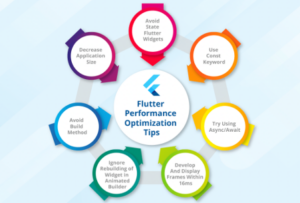Flutter’s versatility and powerful UI capabilities have made it a leading choice for building cross-platform mobile apps. However, its resource-intensive nature requires developers to fine-tune performance to create smooth, responsive, and memory-efficient apps. This guide compiles essential optimization techniques to help you craft a stellar Flutter experience.

1. Widget and Layout Optimization
Flutter’s widget-based design is its biggest strength, but it can lead to inefficiencies if not managed properly. Optimize your widgets to reduce unnecessary rebuilding:
- Minimize Widget Rebuilds: Use const constructors whenever possible to signal Flutter that a widget doesn’t need to be rebuilt.
- Strategic Stateful Widgets: Wrap only dynamic parts of your UI in StatefulWidget. Avoid wrapping large widget trees to reduce the overhead of setState().
- Use Keys Wisely: Leverage ValueKey or UniqueKey for widgets in lists or complex layouts. This ensures efficient state management and prevents unnecessary reordering.
2. Simplify Layout Complexity
Keep your widget tree as shallow and efficient as possible:
- Avoid Deep Widget Trees: Flatten widget hierarchies to prevent excessive layout calculations.
- Leverage const Widgets: Const widgets don’t require rebuilding, improving memory, and rendering efficiency.
3. Image and Asset Optimization
Heavy images can slow down your app. Optimize them to improve performance:
- Cache Images: Use the cached_network_image package to store network-loaded images locally, minimizing repeated calls.
- Compress and Resize: Compress images before adding them to your project. Use JPEG for photos and PNG for graphics, or switch to SVG for scalable vector images.
- Use Image.asset for Local Images: It is faster and more efficient compared to network or file-based alternatives.
4. Asynchronous Programming and Network Optimization
Flutter’s asynchronous nature allows for smooth UI updates, but heavy tasks can still bog down performance:
- Use FutureBuilder and StreamBuilder: These widgets enable responsive UI by handling asynchronous data without blocking the main thread.
- Offload Heavy Tasks to Isolates: Use Isolates for CPU-intensive operations like data parsing, keeping the UI thread free.
- Cache API Responses: Minimize redundant network requests and implement caching for faster data loading.
5. Optimize Rendering with Repaint Boundaries
Rendering optimizations can drastically reduce jank:
- Utilize RepaintBoundary: Wrap frequently changing parts of the UI to isolate their rendering layers. This prevents the entire screen from being redrawn.
- Monitor GPU and CPU Usage: Use Flutter’s Performance Overlay and DevTools to detect high frame rendering times and optimize problem areas.
6. Master Memory Management
Efficient memory usage ensures your app runs smoothly, even on low-end devices:
- Avoid Large Objects in State: Keep memory-heavy objects like large lists or images out of the widget state.
- Dispose of Controllers: Always dispose of unused controllers (e.g., AnimationController, TextEditingController) to free up resources.
- Reuse Objects: Reduce memory churn by reusing objects instead of creating new ones in frequently-called methods like build.
7. Streamline Navigation and Route Management
Keep memory consumption in check while navigating between screens:
- Optimize Routes: Use Navigator.pushReplacement to remove unnecessary routes from the stack.
- Lazy Loading Screens: Load screen resources dynamically to reduce initial load time and memory usage.
8. Enhance Startup Performance
First impressions matter! Reduce your app’s startup time with these tips:
- Defer Initialization: Delays non-essential tasks (e.g., analytics, feature checks) until after the home screen is loaded.
- Streamline Splash Screens: Keep splash screens lightweight and avoid heavy operations in the main() function.
- Build for Release Mode: Always use the –release flag for production builds to enable full optimizations.
9. Use Flutter DevTools for Profiling
DevTools is your best friend for diagnosing performance bottlenecks:
- Track Widget Rebuilds: Identify excessive rebuilds and optimize them.
- Monitor Memory Usage: Spot memory leaks and manage object disposal.
- Analyze Network Calls: Detect redundant API calls and improve network efficiency.
10. Optimize Third-Party Plugins
Plugins can simplify development but may introduce inefficiencies:
- Audit Plugins: Use well-maintained plugins with good benchmarks and avoid bloated ones.
- Prune Dependencies: Regularly review your pubspec.yaml to remove unused dependencies.
11. Target Low-End Devices
Expand your app’s reach by optimizing for devices with limited resources:
- Reduce Animations: Provide options to disable or simplify animations.
- Lower Image Quality: Dynamically adjust asset resolutions based on the device’s capabilities.
- Test on Low-End Devices: Regularly test performance on older hardware to identify potential issues.
12. Optimize State Management
Efficient state management reduces unnecessary widget rebuilds:
- Choose the Right Solution: Evaluate state management tools like Provider, Bloc, Riverpod, or GetX based on your app’s complexity.
- Localize State Updates: Keep state changes localized to the smallest possible widget subtree.
13. Shrink App Size
Minimize your app’s footprint for faster downloads and better performance:
- Enable Code Shrinking: Use Dart’s tree-shaking feature and ProGuard (for Android) to remove unused code.
- Split APKs or App Bundles: Deliver architecture-specific binaries to reduce download size.
- Compress Assets: Use tools like TinyPNG or WebP for image compression.
14. Plan for Error Handling
Unoptimized error handling can harm user experience:
- Provide Fallback UIs: Display lightweight placeholders for loading or error states.
- Retry Mechanisms: Implement robust retry logic for failed actions, reducing frustration.
15. Code Splitting for Large Apps
Modularize your app to load features dynamically:
- Lazy Load Modules: Load screens or modules on demand to reduce the initial app load.
- Dynamic Localization: Load translations dynamically instead of bundling all languages.
Final Thoughts on Flutter Optimization
Flutter’s powerful capabilities make it possible to create stunning, high-performance apps. However, achieving smooth Flutter performance requires careful planning, constant profiling, and iterative optimizations. Following these optimization techniques, you’ll improve your Flutter app’s responsiveness and delight your users with a seamless experience.
Start implementing these strategies today and take your Flutter app to the next level! 🚀

